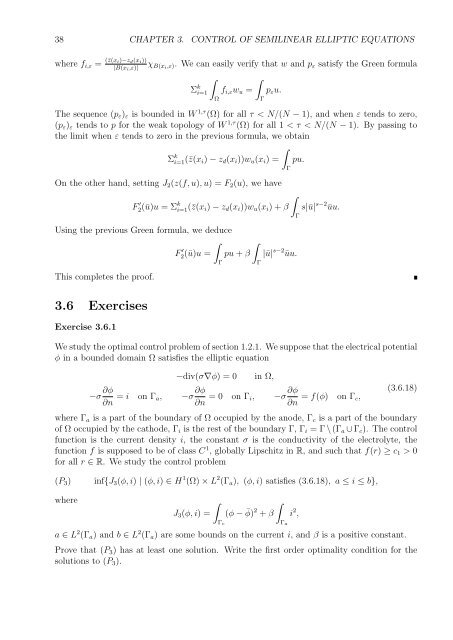Optimal Control of Partial Differential Equations
Optimal Control of Partial Differential Equations
Optimal Control of Partial Differential Equations
You also want an ePaper? Increase the reach of your titles
YUMPU automatically turns print PDFs into web optimized ePapers that Google loves.
38 CHAPTER 3. CONTROL OF SEMILINEAR ELLIPTIC EQUATIONS<br />
where fi,ε = (¯z(xi)−zd(xi))<br />
|B(xi,ε)|<br />
χB(xi,ε). We can easily verify that w and pε satisfy the Green formula<br />
Σ k i=1<br />
<br />
fi,εwu =<br />
Ω<br />
The sequence (pε)ε is bounded in W 1,τ (Ω) for all τ < N/(N − 1), and when ε tends to zero,<br />
(pε)ε tends to p for the weak topology <strong>of</strong> W 1,τ (Ω) for all 1 < τ < N/(N − 1). By passing to<br />
the limit when ε tends to zero in the previous formula, we obtain<br />
Σ k <br />
i=1(¯z(xi) − zd(xi))wu(xi) = pu.<br />
<br />
Γ<br />
pεu.<br />
On the other hand, setting J2(z(f, u), u) = F2(u), we have<br />
F ′ 2(ū)u = Σ k <br />
i=1(¯z(xi) − zd(xi))wu(xi) + β<br />
Using the previous Green formula, we deduce<br />
F ′ <br />
2(ū)u = pu + β<br />
This completes the pro<strong>of</strong>.<br />
3.6 Exercises<br />
Exercise 3.6.1<br />
Γ<br />
Γ<br />
Γ<br />
|ū| s−2 ūu.<br />
Γ<br />
s|ū| s−2 ūu.<br />
We study the optimal control problem <strong>of</strong> section 1.2.1. We suppose that the electrical potential<br />
φ in a bounded domain Ω satisfies the elliptic equation<br />
−div(σ∇φ) = 0 in Ω,<br />
−σ ∂φ<br />
∂n = i on Γa, −σ ∂φ<br />
∂n = 0 on Γi, −σ ∂φ<br />
∂n<br />
= f(φ) on Γc,<br />
(3.6.18)<br />
where Γa is a part <strong>of</strong> the boundary <strong>of</strong> Ω occupied by the anode, Γc is a part <strong>of</strong> the boundary<br />
<strong>of</strong> Ω occupied by the cathode, Γi is the rest <strong>of</strong> the boundary Γ, Γi = Γ \ (Γa ∪ Γc). The control<br />
function is the current density i, the constant σ is the conductivity <strong>of</strong> the electrolyte, the<br />
function f is supposed to be <strong>of</strong> class C 1 , globally Lipschitz in R, and such that f(r) ≥ c1 > 0<br />
for all r ∈ R. We study the control problem<br />
(P3) inf{J3(φ, i) | (φ, i) ∈ H 1 (Ω) × L 2 (Γa), (φ, i) satisfies (3.6.18), a ≤ i ≤ b},<br />
where<br />
<br />
J3(φ, i) =<br />
Γc<br />
(φ − ¯ φ) 2 <br />
+ β<br />
a ∈ L 2 (Γa) and b ∈ L 2 (Γa) are some bounds on the current i, and β is a positive constant.<br />
Prove that (P3) has at least one solution. Write the first order optimality condition for the<br />
solutions to (P3).<br />
Γa<br />
i 2 ,

















